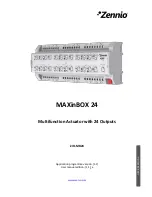UM10503
All information provided in this document is subject to legal disclaimers.
© NXP B.V. 2012. All rights reserved.
User manual
Rev. 1.3 — 6 July 2012
730 of 1269
NXP Semiconductors
UM10503
Chapter 26: LPC43xx Ethernet
26.7.4.2 Clock types
The Ethernet controller supports the following clock types defined in the IEEE 1588-2008
standard:
•
Ordinary clock
•
Boundary clock
•
End-to-end transparent clock
•
Peer-to-peer transparent clock
26.7.4.2.1
Ordinary clock
The ordinary clock in a domain supports a single copy of the protocol. The ordinary clock
has a single PTP state and a single physical port. In typical industrial automation
applications, an ordinary clock is associated with an application device such as a sensor
or an actuator. In telecommunications applications, the ordinary clock can be associated
with a timing demarcation device.
The ordinary clock can be a grandmaster or a slave clock. The ordinary clock supports the
following features:
•
Send and receives PTP messages. The timestamp snapshot can be controlled as
described in
•
Maintains the data sets such as timestamp values.
For an ordinary clock, you can take the snapshot of either one of the following PTP
message types: version 1 or version 2. You cannot take the snapshots for both PTP
message types. You can take the snapshot by setting the control bit (TSVER2ENA) and
selecting the snapshot mode in
.
26.7.4.2.2
Boundary clock
The boundary clock typically has several physical ports communicating with the network.
The messages related to synchronization, master-slave hierarchy, and signaling terminate
in the protocol engine of the boundary clock and are not forwarded. The PTP message
type status given by the core (see .
) helps you to identify the type of
message and take appropriate action.
The boundary clock is similar to the ordinary clock except for the following features:
•
The clock data sets are common to all ports of the boundary clock .
•
The local clock is common to all ports of the boundary clock.
Therefore, the features of the ordinary clock are also applicable to the boundary clock.
26.7.4.2.3
End-to-end transparent clock
The end-to-end transparent clock supports the end-to-end delay measurement
mechanism between slave clocks and the master clock. The end-to-end transparent clock
forwards all messages like normal bridge, router, or repeater. The residence time of a PTP
packet is the time taken by the PTP packet from the Ingress port to the Egress port.
Table 577. Ordinary clock: PTP messages for snapshot
Master
Slave
Delay_Req
SYNC

















